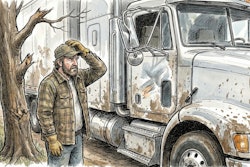
John Doe was driving his tractor and van trailer up a slight grade on a two-lane highway in the Rockies. The road was almost completely clear as he approached the top of a grade at just over 40 mph in the ninth gear of his 10-speed transmission. There had been snow the day before. Doe had pondered the issue of speed and had decided that running at this speed should give him an ideal margin of safety with a posted limit of 50. He took a sip of his coffee and then popped another Gummy Bear into his mouth.
As Doe crested a hill, his heart sank. Ahead and slightly to his right–stalled not far from the center of his lane–was a dark-colored pickup truck that had spun around and stalled. A white pickup that had just steered around it had lost control, and now was sliding rapidly on ice, headed for the guardrail on the right.
Doe applied moderate brake pressure in hopes of increasing his chances of avoiding the two pickups. Alas, the tandems of his older, ABS-less trailer quickly lost their grip on the road’s slick surface. He watched in horror in his right side mirror as the trailer’s rear began sliding right. Although his tractor continued to move straight ahead near the middle of the road, the trailer soon had swung out until it was at nearly a 45-degree angle to the tractor.
Fortunately, the trailer was still a few feet from the shoulder, and 15 feet or more from the guardrail. Unfortunately, it was also clear that would not be far enough away from the guardrail to avoid the other vehicle.
The rest of the ballet was choreographed in agonizing slow motion. With insufficient time to further reduce his speed or release the brakes and get the trailer back in line, he soon heard a “crunch” as the stalled pickup collided with the trailer tandems and the box. This collision caused the pickup to be dragged along with Doe as he gradually continued to lose speed. Soon, it was forced against the guardrail.
As if this were not enough drama, Doe watched, feeling paralyzed, as the white pickup slammed the guardrail on its own. Soon, there was another crunch as Doe's trailer—still pushing the dark pickup that was now stuck to it—shoved the white truck up and over the guardrail where it came to rest. As Doe’s rig finally came to a halt, his only consolation was the apparent fact that both collisions had occurred at a moderate speed. There were no injuries, but lots of property damage.
Was this accident preventable?
The director of safety of Doe’s fleet declared the accident preventable, citing how common sudden degradations in road conditions can be in the mountains in wintertime. Doe protested, saying there was no way he could have known what was ahead.
The data was submitted to the National Safety Council’s Accident Review Committee for its opinion. They ruled the accident eminently preventable, saying that Doe was proceeding “too fast for conditions. Knowing what the weather had been like, more caution should have been used when cresting the hill.”










